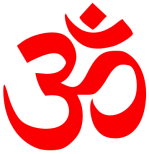What is Om?
Omkar recitation is considered to be an important yogic practice. It is very common to start or end a yoga or meditation session with Omkar recitation. All mantras generally begin and often also end with Om.
Why chant OM and what is the significance of this sound?
The OM mantra has been mentioned in many of the ancient texts related to yoga. In many of the Upanishads, it is revered as representing everything that is manifest and yet has its roots in the unmanifest. The Mandukya Upanishad, in particular, is fully devoted to the discussion of OM. In the Upanishads, OM is mentioned as being the same as Brahman (the supreme consciousness).
Om (or Aum) is a universal sound that represents a connectedness to all that is.
“tasya vachakah prannavah”
Patanjali in his Yoga sutra 1.27, tells us that the sound of Pranava (OM) represents Ishvara (our Divine Source). In the following two sutras, he tells us, the repetition of this syllable reveals its meaning and from this practice, all the obstacles disappear and simultaneously dawns knowledge of the inner Self.
Om represents all time: past, present, and future; and is beyond time itself. Om represents the eternal oneness of all that is, and is the ultimate goal of yoga: to become unified in body, mind, and spirit.
Om reminds us that everything around us, including ourselves contains aspects of the divine. As we make the sound of Om we acknowledge the connection we have to all things.

The History and Universality of OM
The origin of the syllable OM is lost in a misty past. Because it is not specific to any one country or civilization, it is indicative of being a universally perceptible sound for the human race. The reason for this universal perceptibility possibly lies in the fact that “AAAH” is the most natural sound that issues from the human larynx. This is evident when a man cries out naturally in extreme pain, anger or fear. When emotions reach an extreme pitch, the articulate sounds evolved by man are not the ones that are heard, but the syllable natural to man which is “AAAH”.
According to ancient beliefs, all speech and thought originated from the sound of “aum”. It is often correlated with “The Word” of the Bible, as the Holy Spirit. The sacred word ‘hum’ in Tibetan culture, “amin” in Islamic tradition, and “amen” in the beliefs of Egyptians, Greeks, Romans, Jews, and Christians, are all thought to have their origins traced back to the universal sound “aum.”
In Arabic, the first alphabet is pronounced as “aliph”. In Greek it is “alpha”, and in the Roman script, it is A. In many languages, the first letter in the alphabet has the syllable A, with which the word AUM or OM begins. In the Greek alphabet, the last letter is Omega which comes very close to OM. Thus the significance of the syllable OM as the beginning and end finds a parallel in many of the scripts associated with ancient languages.
This indicates some link between the various symbols, and perhaps a common origin. Even in the English language, the “Om” occurs in words having a similar meaning. for instance; Omniscience means infinite knowledge, Omnipotent means having infinite powers Omnivorous means eating or reading everything. This syllable also occurs in words such as Omen which means a sign of something that is to occur in the future, Ombudsman means a person having authority to pronounce a verdict. Thus Om is also used to signify divinity and authority.
There are many interpretations of the sound; including the three sounds A-U-M represent creation, preservation, and destruction. According to B.K.S. Iyengar’s Light on Yoga:
- The letter A symbolizes the conscious or waking state
- The letter U the dream state
- The letter M the dreamless sleep state of the mind and spirit
- A-U-M in its wholeness represents the “realization of man’s divinity within himself.”

How to Chant OM?
There are many schools of thought that describe how to perform “OM”:
- Sit in a comfortable cross-legged seated posture with the spine upright, head, neck, and spine in a vertical (if comfortable) alignment.
- Close your eyes and take a deep inhalation.
- While exhaling start uttering the OM sound.
- Begin by feeling the vibration of the “O” sound building up in the navel area and traveling upward.
- As you continue the chant, feel the vibration moving upward toward the base of the throat.
- When the vibration reaches the throat area, convert the sound to a deep humming sound of “M”.
- Continue to feel the vibration moving upward until it reaches the crown of the head (called Sahasrara Chakra).
- You may repeat this process two or more times. At the end of the final chant, continue to sit still and feel the vibration of the OM sound permeating the whole body – every single cell of the body.

By contemplating the meaning of each of these letters as we chant them, we are led through the three states of our ordinary consciousness to the mantra’s fourth part, the anusvara (after-sound): om. The vibration slowly dissolves into silence, symbolic of the transcendent state of consciousness, equated with Brahman (the Absolute). This silence is the crown of the mantra; it is described in the Maitri Upanishad as “tranquil, soundless, fearless, sorrowless, blissful, satisfied, steadfast, immovable, immortal, unshaken, enduring.
“…Supreme silence… Primeval Sound…”
Some yogis believe there is no need to say the mantra aloud. Chant it to yourself, deeply and lengthily. Chant without moving your lips or tongue. Let each repetition bring you back to yourself. When you continue this for a while, you will suddenly realize that the chanting has fallen away, and the mind has become silent.
Benefits of chanting OM
The vibrations due to Omkar recitation increase the efficiency of cells and the concerned organs.
In the Omkar recitation,
- the first pronunciation A creates vibrations, which affect the spinal cord to increase its efficiency.
- The second pronunciation U creates vibrations in the throat and affects the thyroid glands.
- The last pronunciation M, brings the vibrations to the brain, thereby activating the brain centers, as a result of which, the efficiency of the brain increases.
Therefore the effect of Omkar chanting increases the concentration, memory, and receiving power of the brain and ultimately decreases fatigue.
The continued recitation of OM fills one with peace, calmness, tranquility, and serenity. When we recite it with the understanding that OM is nothing but a representation of Ishvara, it brings us closer to our true nature, our own pure self. As mentioned above, OM is the primordial sound, and all of creation is a manifestation of this mystic sound. It represents the cosmic prana (the vital energy) and the air we breathe. Meditating on these thoughts can bring us closer to other human beings and lift the veil of separateness.
OM is the sound of the breath vibrating in the Universe and within us.
Omkaaram Bindu-Samyuktam Nityam Dhyaayanti Yoginah |
Kaamadam Mokssadam Caiva Omkaaraaya Namo Namah ||1||
Om, which is united with the Source,
On which the Yogis ever dwell,
Which grants desires and liberation,
I salute the Omkar.

